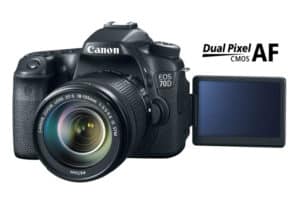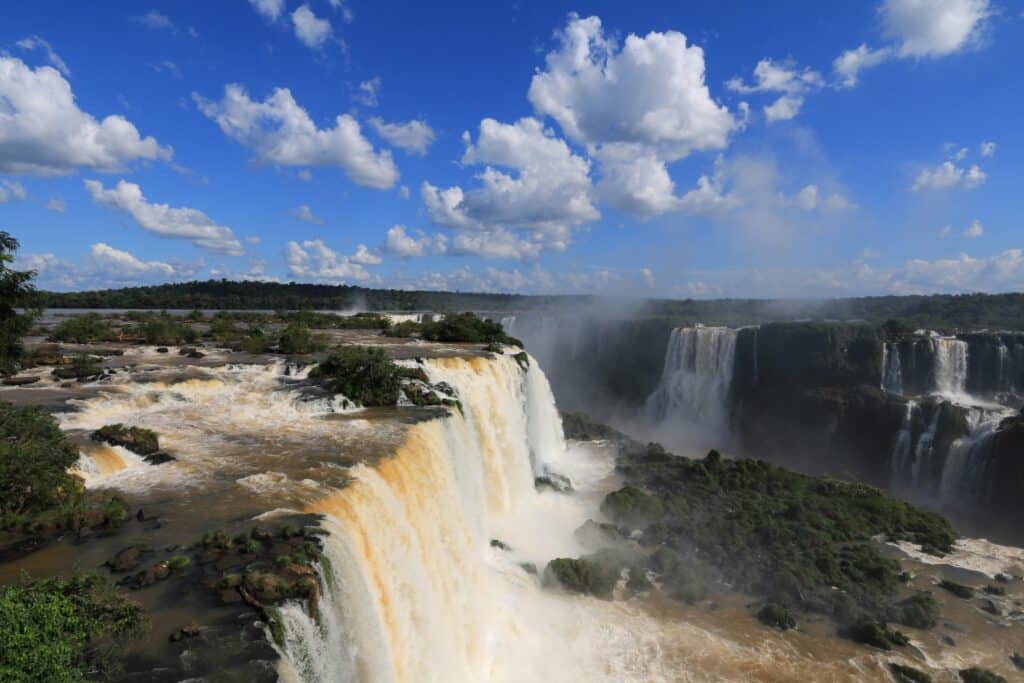When you purchase through links on our site, we may earn an affiliate commission. Here’s how it works.
Canon EOS 70D Review
The latest masterpiece from Canon
The Canon EOS 70D is surely the first DSLR that has arrived with an on-chip phase-detect autofocus system that is not dependent solely on the contrast-detection feature to ensure focus.
This further enables this masterpiece to offer fast and smooth autofocus while recording the videos, even though it falters a bit in the dim lighting.
Canon DSLR EOS 70D with flip screen is a perfect fit for all the Canon shooters who want to go beyond its contemporary look without going to a full-frame.
Even though it delivers pretty well in the video aspect, unlike Canon flip screen cameras, it falls a bit short with the Nikon D7100, which has been largely deemed as the perfect DSLR in the mid-price range.
Pros
- Smooth video autofocus
- Lucid touch-screen LCD.
- Cutting-edge pentaprism optical viewfinder
- Quick focus
- 7fps nonstop drive shooting
- Tons of physical controls
- Availability of vertical grip add-on
- Flash sync speed of 1/250-second
- Integrated Wi-Fi
Cons
- Live view autofocus falters in dim lighting
- Only a single SD card slot
- No built-in GPS
- Absence of PC sync socket
- 1080p video confined to only 30fps
- Inability to record video with enabled WIFI
Canon EOS 70D Review
The Canon EOS 70D flip screen comes as the only traditional DSLR that offers the smoothest live view autofocus, even though it falls a bit to lock that focus in low light.
Design and controls of Canon 70D

Canon EOS 70D DSLR with flip screen
The Canon EOS 70D is quite big, and it measures 4.1 by 5.5 by 3.1 inches and weighs around 1.7 pounds.
Even though the big size may be a constraint for a few, all the extra physical controls and a bigger, heavier pentaprism viewfinder efficiently compensate for the same.
The Pentaprism viewfinder can be taken as an upgraded version of the Pentamirror, which has been present in the Rebel T5i.
It’s a pretty robust piece of glass and a reflex mirror that diverts the light the lens captures directly to your eye.
Although it won’t offer you full-frame coverage, Canon asserts that it will deliver almost 98 percent of the image captured by the lens, with some information absent on the edges.
Well, that is where its rivals, the Nikon D7100 and Pentax K-5 II, perform better as both deliver 100 percent of the coming frame to your eye.
Right now, you expect it from a traditional DSLR. You will find Canon EOS 70D loaded with lots of controls. At the edge of the lens mount, you will find a preview button to control the depth of the field.
On the other side, you will see a mode dial control on the left of the eyepiece right at the top plate. It will come as locked, so you have to turn it on while pressing the center button.
Right below that dial, you will find the power switch.
A monochrome information LCD is located to the right of the finder, along with buttons ahead to control the autofocus mode, ISO, drive mode, and metering pattern.
You will also find a small button in front of that, enabling you to control and adjust the shutter and active focus points.
Functions of Canon 70D
The rear camera and focus points of Canon 70D
The rear front of the camera is quite basic, with all the info buttons, a menu, and a toggle switch that will allow you to change between the still and video capture, with an inbuilt button to toggle the live view.
Right behind the information display, you will find the AF-ON button to activate the focus, a lock button for exposure, and a button to let you select from any of the 19 focus points of the Canon EOS 70D.
Even though Canon EOS 70D doesn’t offer as many focus points as the D7100, all its focus points are briefly cross-typed.
Shutter Speed and ISO of Canon 70D
The image below was taken with Canon EOS 70d with 1/320 shutter speed

Canon EOS 70D DSLR with flip screen – shutter speed
You will also get a rear control dial and a center set button; in most modes, the given dial will allow you direct access to the exposure compensation adjustment control.
Moreover, the Q button, one of the most common features in Canon SLRs, directly activates a touch-sensitive menu right on the rear LCD.
It further offers smooth and fast control over the shutter speed, aperture, ISO, flash compensation, exposure compensation, picture style, focus mode, white balance, drive mode, metering pattern, image quality, and all the other image optimization settings.
You may find them identical to the usual on-camera controls, but accommodating them in one place creates certain magic to the hands.
1040k-dot resolution
The rear LCD comes with a vari-angle design where the hinged display will allow it to swing out to the side of the camera.
Moreover, it can also be tilted to let you see it with the camera over your head, at your waist, or placed upfront.
The 3-inch display is touch-sensitive and has a fantastic 1040k-dot resolution.
Even though its strong competitor, Sony Alpha 77, also comes with a hinged display, there’s no touch screen available, with the whole hinged display mechanism being slightly different.
Just like the full-frame 6D, the Canon EOS 70D also incorporates Wi-Fi but it still lags behind the 6D due to the absence of GPS.
Like the other Canon cameras, you can easily transfer all the photos to your smartphone or tablet with the free EOS Remote app.
Moreover, you can also print the shot to a Canon Wi-Fi printer, beam it to the other Canon camera, view the shot on an HDTV via DLNA, or upload it immediately to the web.
To upload it to the web, you need to connect the camera to your desktop or laptop and then configure the type of Web service you would like to access via the Canon Image Gateway service.
The EOS Remote app offered by Canon also works well with remote control.
You will see a live view feed on your smartphone or laptop screen; that way, you can easily control and adjust the focus point and exposure compensation while firing the shutter.
Still, the absence of complete manual control is a bit annoying. Moreover, you can’t record a video while the Wi-Fi is on, which is also one of the most significant downsides of Canon EOS 70D.
See Also
